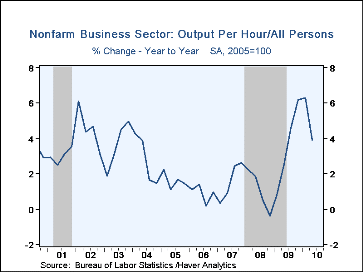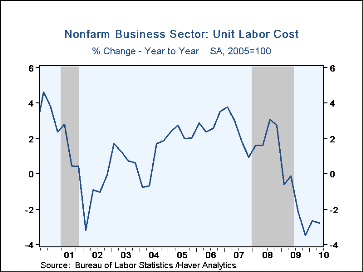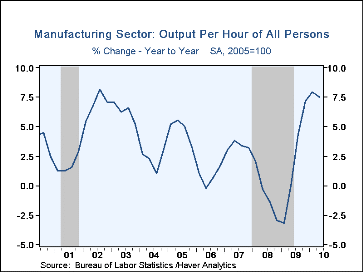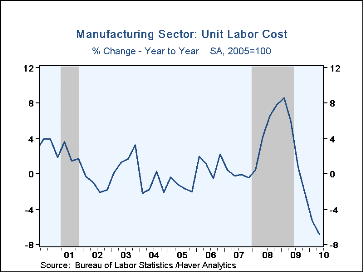 Global| Aug 10 2010
Global| Aug 10 2010U.S. Labor Productivity Decline The First Since 2008
by:Tom Moeller
|in:Economy in Brief
Summary
Labor productivity fell last quarter. A modest uptick had been expected, but the drop is a natural result of slower output growth coupled with a faster increase in labor hours worked. Nonfarm business sector productivity fell 0.9% [...]
Labor productivity fell last quarter. A modest uptick had been expected, but the drop is a natural result of slower output growth coupled with a faster increase in labor hours worked. Nonfarm business sector productivity fell 0.9% (AR) following an upwardly revised 3.9% 1Q increase. It was the first productivity decline since 4Q08 and was accompanied by modest, downward annual revisions back to 2007. Nevertheless, productivity's 3.9% rise during the last four quarters remained up from growth rates during the last seven years. New technologies, improved work techniques and improved labor skill-sets continue to pay dividends.
Last quarter's decline in productivity was the function of a halving in output growth to 2.6% (3.9% y/y) and a tripling to 3.6% (-0.0%) in growth in hours worked.The combination overwhelmed the modest quarterly decline in compensation costs of 0.7% and caused unit labor costs to rise a slight 0.2% after three consecutive quarterly declines. The four-quarter decline in costs of 2.8% still was near the largest on record.
In the factory sector alone, worker productivity growth remained robust at 4.5% (7.2% y/y), up from a 1.2% gain during 1Q. The pickup occurred as output rose at an accelerated 8.3% rate (8.3% y/y) and growth in hours-worked rose just 3.6% (0.8% y/y) following a 5.7% 1Q increase. Compensation fell for the second consecutive quarter (+0.1% y/y). The combination of the rise in productivity and the slip in compensation lowered unit labor costs to a 6.1% rate (-6.9% y/y), the most on record.
The productivity & cost figures are available in Haver's USECON database.
Future Recession Risks from the Federal Reserve Bank of San Francisco can be found here.
| Nonfarm Business Sector (SAAR,%) | Q2'10 | Q1 '10 | Q4 '09 | Q2 Y/Y | 2009 | 2008 | 2007 |
|---|---|---|---|---|---|---|---|
| Output per Hour (Productivity) | -0.9 | 3.9 | 6.0 | 3.9 | 3.5 | 1.0 | 1.6 |
| Compensation per Hour | -0.7 | 0.0 | 1.5 | 1.0 | 1.9 | 3.3 | 4.0 |
| Unit Labor Costs | 0.2 | -3.7 | -4.2 | -2.8 | -1.6 | 2.2 | 2.4 |
| Manufacturing Sector | |||||||
| Output per Hour | 4.5 | 1.2 | 8.1 | 7.5 | 2.0 | -0.7 | 3.4 |
| Compensation per Hour | -1.9 | -5.0 | 4.4 | 0.1 | 5.2 | 4.0 | 3.3 |
| Unit Labor Costs | -6.1 | -6.2 | -3.5 | -6.9 | 3.1 | 4.7 | -0.1 |
Tom Moeller
AuthorMore in Author Profile »Prior to joining Haver Analytics in 2000, Mr. Moeller worked as the Economist at Chancellor Capital Management from 1985 to 1999. There, he developed comprehensive economic forecasts and interpreted economic data for equity and fixed income portfolio managers. Also at Chancellor, Mr. Moeller worked as an equity analyst and was responsible for researching and rating companies in the economically sensitive automobile and housing industries for investment in Chancellor’s equity portfolio. Prior to joining Chancellor, Mr. Moeller was an Economist at Citibank from 1979 to 1984. He also analyzed pricing behavior in the metals industry for the Council on Wage and Price Stability in Washington, D.C. In 1999, Mr. Moeller received the award for most accurate forecast from the Forecasters' Club of New York. From 1990 to 1992 he was President of the New York Association for Business Economists. Mr. Moeller earned an M.B.A. in Finance from Fordham University, where he graduated in 1987. He holds a Bachelor of Arts in Economics from George Washington University.










